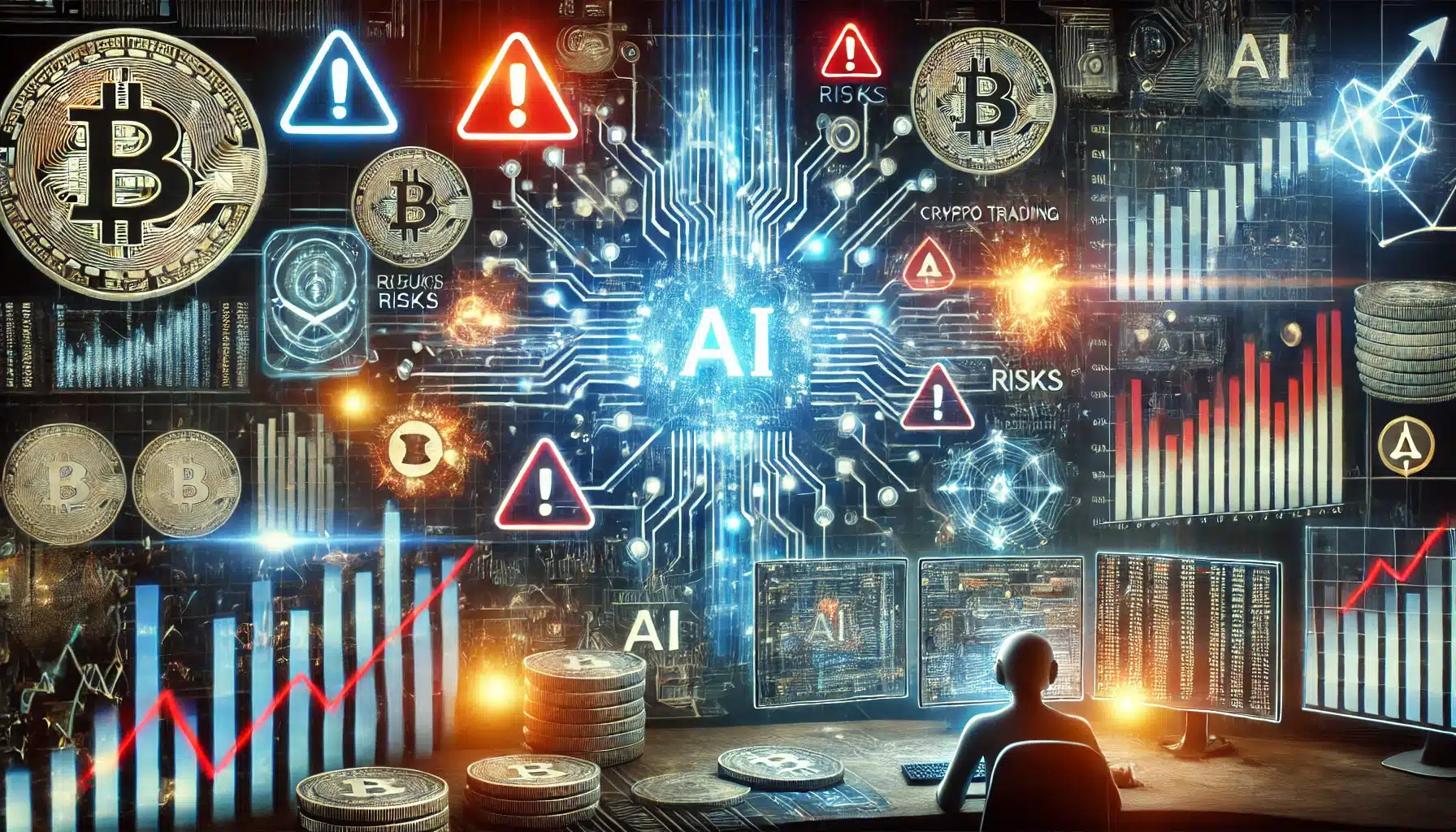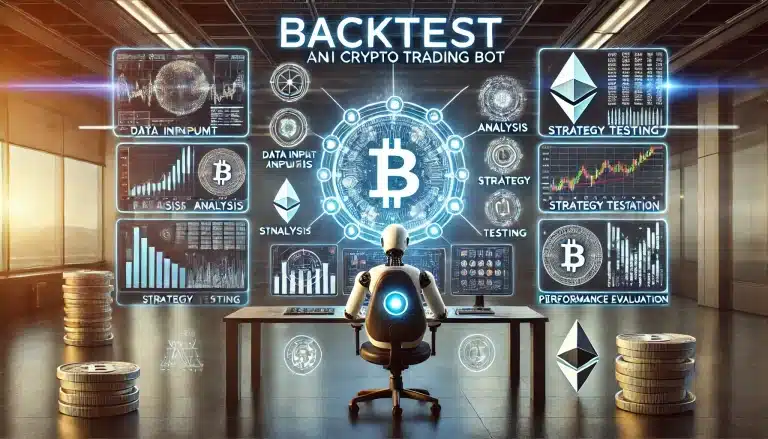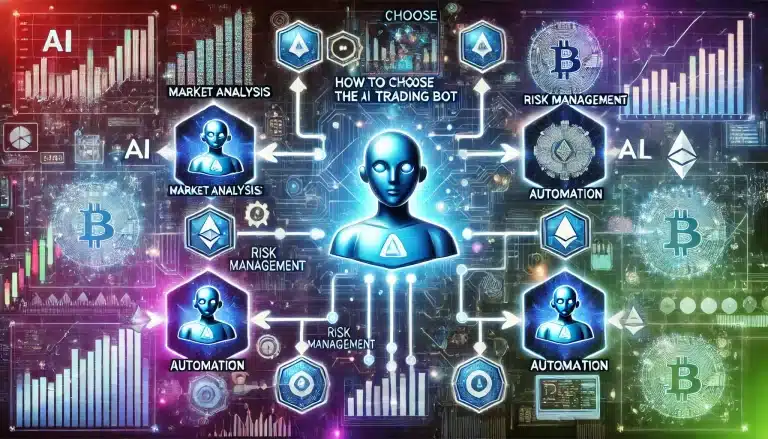Whoa, hold onto your digital wallets, folks!
The world of cryptocurrency is already a wild ride, but throw AI into the mix, and you’ve got a recipe for excitement – and potential disaster.
Did you know that in 2024, AI-driven trading accounted for over 70% of daily trading volume in some crypto exchanges?
That’s mind-blowing! But before you jump on the AI crypto bandwagon, let’s take a deep dive into the risky waters of this cutting-edge technology. Trust me, you’ll want to know what you’re getting into!
The Rise of AI in Cryptocurrency Trading

Oh boy, let me tell you about my journey into the world of AI and crypto trading. It’s been a wild ride, to say the least! I remember when I first dipped my toes into the crypto waters back in 2017. I was like a kid in a candy store, buying whatever coin had the coolest logo. Yeah, not my finest moment.
Fast forward a few years, and I started hearing whispers about these fancy AI trading bots. At first, I was skeptical. I mean, could a computer really outsmart human traders? Turns out, they can – and in ways I never imagined.
So, I did what any curious trader would do: I dove headfirst into learning about AI in crypto trading. And let me tell you, it was like trying to drink from a firehose! The amount of information out there is mind-boggling.
Here’s the thing: AI isn’t new to financial markets. Wall Street’s been using algorithms for years. But crypto? That’s a whole different ballgame. The 24/7 nature of crypto markets makes it perfect for AI trading bots. These little digital geniuses never sleep, never get tired, and never make emotional decisions based on FOMO or FUD.
I remember the first time I used an AI trading bot. I felt like a proper tech wizard, watching it analyze market data and execute trades faster than I could blink. It was analyzing stuff I’d never even thought of – social media sentiment, news articles, you name it. All in real-time! I was gobsmacked.
But here’s where it gets really interesting. The adoption of AI in crypto trading has skyrocketed. Last I checked, some exchanges were seeing over 70% of their daily trading volume coming from AI-driven systems. That’s bonkers!
Now, I’m not gonna lie – it hasn’t all been smooth sailing. There’ve been times when my AI bot made decisions that left me scratching my head. Like that one time it decided to buy a ton of a coin right before a major dip. Ouch. But that’s part of the learning process, right?
One thing I’ve learned is that AI in crypto trading isn’t just about making quick trades. It’s about pattern recognition on a massive scale. These systems can spot trends and correlations that would take a human trader years to figure out. It’s like having a super-powered brain analyzing the markets 24/7.
But here’s my advice: don’t just jump in blindly. Take the time to understand how these AI systems work. Learn about machine learning, neural networks, and all that jazz. Trust me, it’ll save you a lot of headaches down the road.
And remember, AI isn’t perfect. It’s a tool, not a magic wand. You still need to use your own judgment and keep an eye on things. I learned that lesson the hard way, but that’s a story for another day.
So, that’s my two cents on the rise of AI in crypto trading. It’s exciting, it’s powerful, and it’s changing the game. But like anything in the crypto world, it comes with its own set of risks and challenges. Stay curious, stay informed, and who knows? Maybe you’ll be the next AI trading whiz!
Potential Benefits of AI-Driven Crypto Trading
Alright, let’s talk about the good stuff – the benefits of AI in crypto trading. Trust me, after my fair share of late nights staring at charts and making impulsive trades, I’ve come to appreciate what these digital brainiacs can do.
First off, speed. Holy moly, these AI systems are fast! I remember the days when I’d spot a potentially profitable trade, fumble with my phone to open my trading app, and by the time I placed the order, the opportunity was gone. Talk about frustrating! But AI? It’s like having The Flash as your personal trader. These systems can analyze market conditions and execute trades in milliseconds. It’s mind-blowing!
One time, I was watching my AI bot during a particularly volatile day. The market was going haywire, and before I could even process what was happening, my bot had already made a series of trades that ended up being quite profitable. I just sat there, mouth agape, thinking, “Well, I guess that’s why I don’t try to outspeed the machines!”
But it’s not just about speed. These AI systems can crunch massive amounts of data in real-time. We’re talking price movements, trading volumes, social media sentiment, news articles – you name it. It’s like having a team of super-analysts working for you 24/7. And let me tell you, as someone who used to spend hours poring over charts and news feeds, this is a game-changer.
Now, here’s something I really appreciate about AI trading: it doesn’t have emotions. Unlike yours truly, who may or may not have panic sold during a dip (okay, I definitely did), AI doesn’t get scared, excited, or greedy. It sticks to its programming and executes trades based on data, not feelings. That’s huge in a market as volatile as crypto.
Oh, and did I mention these things never sleep? While I’m catching my Z’s or binge-watching the latest Netflix series, my best AI trading bot is keeping an eagle eye on the markets. It’s like having a tireless, ultra-focused trading partner who never needs a coffee break.
But here’s the kicker – AI can spot patterns and correlations that human traders might miss. I remember one instance where my bot made a series of trades that seemed odd to me at first. But when I dug into the data, I realized it had identified a complex pattern across multiple coins that I never would’ve spotted on my own. It was a real “aha” moment for me.
Now, don’t get me wrong – AI isn’t perfect, and it’s not a guaranteed path to riches. I’ve had my fair share of hiccups and learning experiences with AI trading. But the potential benefits? They’re pretty darn impressive.
Just remember, folks – AI is a tool, not a magic wand. It’s still crucial to understand the basics of trading and to keep an eye on your AI system. Think of it as a very smart assistant, not a replacement for your own judgment.
So, there you have it – the potential benefits of AI-driven crypto trading, straight from someone who’s been in the trenches. It’s exciting stuff, and I can’t wait to see how it continues to evolve. Who knows? Maybe one day we’ll have AI that can predict the next big meme coin. Now wouldn’t that be something?
Market Volatility and AI Trading Risks
Okay, folks, let’s talk about the elephant in the room – market volatility and the risks that come with AI trading. Buckle up, because this is where things get really interesting (and sometimes a little scary).
First off, let me tell you about the time I learned just how wild crypto volatility can be. It was 2021, and I’d set up my fancy new AI trading bot. I felt like a tech genius, ready to rake in the profits. Then, boom! Elon Musk tweets about Bitcoin, and the whole market goes bananas. My bot started making trades faster than I could blink, and let me tell you, it was like watching a car crash in slow motion.
See, here’s the thing about AI and volatility – it’s a double-edged sword. These systems can react to market changes way faster than we humans can, which is great… until it’s not. In highly volatile conditions, AI can sometimes amplify market movements, leading to what we call flash crashes.
I remember watching in horror as my bot, along with probably thousands of others, started selling off a particular coin all at once. The price plummeted so fast it made my head spin. It recovered pretty quickly, but not before I lost a chunk of change. That was a wake-up call, let me tell you.
Now, don’t get me wrong – AI systems are smart, but they’re not infallible. They learn from historical data, but crypto is like that unpredictable friend who never does what you expect. Remember when Bitcoin hit $69,000 in November 2021? I bet a lot of AI systems didn’t see that coming!
And here’s where it gets really tricky – AI can sometimes create a feedback loop. Imagine thousands of bots all programmed similarly, all reacting to the same market signals. It’s like a herd of digital wildebeest all deciding to stampede at once. Not pretty.
I’ve seen it happen – a minor dip turns into a major crash because all the AI systems decide to sell at the same time. It’s like watching dominoes fall, except each domino is a chunk of your investment.
But it’s not all doom and gloom. These risks have led to some interesting developments. I’ve learned to set stricter parameters for my AI trades, especially during volatile periods. And many advanced systems now incorporate circuit breakers or cooling-off periods to prevent runaway trading.
One time, during a particularly volatile week, I decided to run an experiment. I let my AI bot trade on one account, while I manually traded on another. Guess what? The AI actually outperformed me, even with all the craziness. It made some losses, sure, but it also caught some upswings that I missed while I was busy panicking.
The key takeaway? AI can be a powerful tool for navigating market volatility, but it’s not foolproof. You’ve got to stay vigilant, understand the risks, and be ready to step in when things get too wild.
So, my advice? Don’t just set and forget your AI trading system. Keep an eye on it, especially during volatile periods. And for Pete’s sake, don’t risk more than you can afford to lose. Trust me, I learned that lesson the hard way.
Remember, in the world of crypto, volatility is the name of the game. AI can help you play that game better, but it can also amplify the risks if you’re not careful. Stay smart, stay informed, and maybe keep some antacids handy. You might need them!
Algorithmic Biases and Limitations
Alright, let’s dive into the murky waters of algorithmic biases and limitations in AI crypto trading. This is where things get really nerdy, but stick with me – it’s important stuff!
So, picture this: It’s 2022, and I’m feeling pretty smug about my AI trading bot. It’s been making some solid gains, and I’m thinking I’ve cracked the code. Then, out of nowhere, the market does a complete 180. My bot? It’s like a deer in headlights, making all the wrong moves. That’s when I learned about something called “overfitting” the hard way.
See, AI models are only as good as the data they’re trained on. My bot had been killing it in a bull market, but it had no clue what to do when the bears came out to play. It was like trying to use a map of New York to navigate Tokyo – totally lost!
This is a classic example of algorithmic bias. These AI systems can get so good at spotting patterns in historical data that they struggle to adapt when the market throws a curveball. And let me tell you, in crypto, curveballs are the norm, not the exception.
I remember staying up late, poring over my bot’s trading history, trying to figure out where it went wrong. That’s when I had my “aha” moment – it wasn’t just about the amount of data, but the quality and diversity of it. My bot had been trained on a relatively short period of market data, and it just wasn’t prepared for a major shift.
But here’s the kicker – even with tons of diverse data, AI models can still develop biases. They might start seeing patterns that aren’t really there, or give too much weight to certain factors. It’s like that time I convinced myself that every time I wore my lucky socks, my trades did better. Spoiler alert: the socks had nothing to do with it!
And don’t even get me started on the limitations of historical data in predicting future trends. Crypto markets are influenced by so many factors – tweets from tech billionaires, global economic shifts, new regulations. How’s an AI supposed to predict all that?
I learned this lesson the hard way during the 2022 crypto winter. My bot, bless its digital heart, kept trying to “buy the dip” because that strategy had worked so well in the past. But this wasn’t just a dip – it was a freefall. I had to step in and adjust its parameters before it blew through all my funds.
Now, I’m not saying AI is useless – far from it! But you’ve got to understand its limitations. These systems are tools, not crystal balls. They can process data faster than any human, but they can’t predict the future.
So, what’s a crypto trader to do? Well, I’ve learned to take a hybrid approach. I let my AI do its thing, but I keep a close eye on it. I regularly update its training data and adjust its parameters. And most importantly, I don’t rely on it exclusively. Sometimes, good old-fashioned human intuition is what you need.
Remember folks, in the world of AI crypto trading, a healthy dose of skepticism is your best friend. Question your model’s decisions, especially when they seem too good to be true. And always, always be ready to learn and adapt.
Because at the end of the day, the market doesn’t care about your fancy AI model or your lucky socks. It’s gonna do what it’s gonna do. Your job is to be prepared and stay flexible. Trust me, your future self (and your wallet) will thank you!
Security Concerns in AI Crypto Trading
Oh boy, let me tell you about security concerns in AI crypto trading. This is the stuff that keeps me up at night – well, that and the occasional 3 AM price alert!
I remember when I first started using an AI trading bot. I felt like I was living in the future, you know? But then I heard about this guy who had his entire crypto portfolio wiped out because his AI trading system got hacked. Talk about a wake-up call!
See, here’s the thing about AI trading systems – they’re like a gold mine for hackers. Think about it: you’ve got this automated system making trades 24/7, often with access to a significant chunk of your crypto assets. It’s like leaving a vault unlocked and hoping no one notices.
I learned this lesson the hard way when I nearly fell victim to an API key exposure. I had set up my trading bot and, in my excitement, I wasn’t as careful as I should’ve been with my API keys. Long story short, I caught it just in time, but it was a close call. I spent the next week paranoid, changing passwords and double-checking everything.
But it’s not just about keeping your keys safe. These AI systems are complex beasts, and that complexity can be a double-edged sword. More features often mean more potential vulnerabilities. It’s like trying to defend a castle with a hundred doors instead of just one.
And don’t even get me started on adversarial attacks. This is some real sci-fi stuff, folks. Imagine someone feeding false data to your AI, tricking it into making bad trades. It’s like whispering bad advice to a trader, except this trader never sleeps and can make a thousand trades in the blink of an eye.
I once saw a demo of an adversarial attack on an AI trading system. The attackers manipulated market data in a way that was imperceptible to humans but threw the AI for a loop. It was fascinating and terrifying at the same time.
Now, I’m not trying to scare you off AI trading. But you’ve got to take security seriously. It’s not just about protecting your assets; it’s about maintaining the integrity of the entire trading ecosystem.
So, what do I do to stay safe? First off, I treat my API keys like they’re the launch codes for nuclear missiles. Seriously, they’re that important. I use strong, unique passwords, two-factor authentication, the whole nine yards.
I also make sure to use reputable AI trading platforms with a solid track record in security. And let me tell you, researching this stuff is like going down a rabbit hole. But it’s worth it for the peace of mind.
One thing I’ve learned is the importance of regular security audits. I schedule time every month to review my setup, check for any unusual activity, and update everything. It’s a pain, but it’s better than waking up to an empty wallet.
And here’s a pro tip: always have a kill switch. If something looks fishy, you need to be able to shut down your AI trader fast. Trust me, those few seconds can make a big difference.
Remember, folks, in the world of AI crypto trading, security isn’t just a feature – it’s a necessity. It’s like wearing a seatbelt while driving a Formula 1 car. You hope you never need it, but you’d be crazy not to use it.
So, stay vigilant, stay informed, and for Pete’s sake, don’t reuse passwords! Your future self (and your crypto portfolio) will thank you. Now, if you’ll excuse me, I need to go check on my bot. Can’t be too careful, right?
Regulatory and Legal Risks
Whew, buckle up folks, because we’re about to dive into the wild west of crypto regulations and AI trading. Let me tell you, this is one area where things can get messy real quick!
So there I was, feeling like a tech-savvy genius with my AI trading bot, making trades left and right. Then BAM! I hear about this new regulation that could potentially classify AI trading bots as financial advisors. Talk about a curveball!
The thing is, the regulatory landscape for AI in crypto trading is about as clear as mud. It’s like trying to apply traffic laws to flying cars – the technology is moving so fast, the rules can barely keep up. One day you’re in the clear, the next day you might be accidentally breaking a law you didn’t even know existed.
I remember staying up late one night, poring over legal documents, trying to figure out if my trading bot was compliant with the latest regulations. Let me tell you, it was about as fun as watching paint dry, but way more stressful.
And here’s where it gets really tricky – who’s responsible when an AI makes a bad trade? Is it the developer? The user? The trading platform? It’s like trying to pin the tail on a donkey, except the donkey is invisible and keeps moving.
I once heard about this poor guy who got into hot water because his AI bot made some trades that were considered market manipulation. He had no idea it was happening, but guess who the regulators came after? Yep, you guessed it.
Now, don’t get me wrong – I’m all for regulations that protect investors and maintain market integrity. But man, navigating this stuff can be a real headache. It’s like playing a game where the rules keep changing, and no one tells you about the changes until after you’ve made a move.
One time, I thought I had it all figured out. I’d done my research, made sure my bot was compliant with all the current regulations. Then, out of nowhere, a new law gets proposed that could potentially make my entire setup illegal. Talk about sleepless nights!
But here’s the thing – as frustrating as it can be, staying on top of regulations is crucial. It’s like wearing a helmet while riding a motorcycle. Sure, it’s a pain, but it could save your bacon.
So, what do I do to stay on the right side of the law? First off, I make sure to use reputable platforms that take compliance seriously. I also keep a close eye on regulatory news – it’s not the most exciting reading, but it’s necessary.
I’ve also learned to be cautious about using AI for certain types of trades. Things like high-frequency trading or anything that could be seen as market manipulation? I steer clear. It’s just not worth the risk.
And here’s a pro tip: document everything. Every trade, every decision your AI makes – keep a record. If the regulators ever come knocking, you’ll want to be able to explain exactly what your bot was doing and why.
Remember folks, in the world of AI crypto trading, ignorance isn’t bliss – it’s a liability. Stay informed, stay compliant, and when in doubt, consult with a legal expert. Trust me, it’s cheaper than dealing with fines or legal battles down the road.
So, there you have it – the regulatory minefield of AI crypto trading. It’s complex, it’s ever-changing, but hey, that’s part of the excitement, right? …Right? Ah, who am I kidding – it’s a pain in the rear. But it’s a necessary pain if you want to play in this sandbox. Now, if you’ll excuse me, I’ve got some regulatory updates to read. Wish me luck!
Ethical Considerations and Market Manipulation
Alright, folks, let’s dive into the murky waters of ethics in AI crypto trading. This is where things get really interesting – and sometimes, a little uncomfortable.
I remember when I first started using my AI trading bot. I felt like I was on top of the world, watching it make trades faster than I could blink. But then, I stumbled across an article about AI and market manipulation, and let me tell you, it was like a bucket of cold water to the face.
See, here’s the thing about AI in trading – it’s incredibly powerful. And you know what they say about power, right? Yep, it comes with a whole lot of responsibility. The problem is, not everyone takes that responsibility seriously.
I once heard about this group of traders who used AI bots to create artificial pump and dump schemes. They’d use the bots to rapidly buy up a low-cap coin, driving the price up, then sell it off just as quickly. It was like watching a digital version of “The Wolf of Wall Street”, except way less glamorous and way more illegal.
Now, I’m not saying all AI trading is unethical. Far from it! But the potential for abuse is there, and it’s something we all need to be aware of. It’s like giving a toddler a supercomputer – without proper guidance, things can go south real fast.
One of the biggest ethical concerns is the impact of high-frequency trading on market fairness. I mean, how can the average Joe compete with a bot that can make thousands of trades per second? It’s like bringing a knife to a gunfight – you’re outmatched before you even start.
I remember feeling pretty conflicted about this. On one hand, I loved the efficiency of my AI bot. On the other hand, was I contributing to a system that was leaving other traders in the dust? It was enough to keep me up at night, let me tell you.
And don’t even get me started on the accessibility issue. AI trading systems aren’t cheap, and they require a certain level of technical know-how to use effectively. Are we creating a two-tiered market where only the tech-savvy and well-funded can truly compete? It’s a tough question, and I don’t think anyone has a clear answer yet.
But here’s the thing – it’s not all doom and gloom. I’ve seen some really promising developments in the ethical AI trading space. Some platforms are implementing “fairness algorithms” to ensure their bots don’t engage in manipulative behavior. Others are working on making AI trading more accessible to the average investor.
I’ve even started using some of these ethical trading practices myself. For example, I’ve set limits on how frequently my bot can trade, and I avoid trading in low-liquidity markets where my bot’s actions could have an outsized impact.
One time, I noticed my bot was consistently front-running a particular trader’s orders. It wasn’t illegal, but it didn’t sit right with me ethically. So, I tweaked its algorithm to avoid that behavior. Sure, I might have missed out on some profits, but I slept better at night.
Here’s the bottom line, folks – AI in crypto trading is a powerful tool, but like any tool, it can be used for good or ill. It’s up to us, the users, to ensure we’re using it ethically and responsibly.
So, what can you do? Stay informed about the ethical implications of AI trading. Use reputable platforms that prioritize fair trading practices. And most importantly, always ask yourself – if everyone traded the way I do, would the market still be fair and accessible?
Remember, in the world of crypto, we’re not just trading digital assets – we’re shaping the future of finance. Let’s make sure it’s a future we can all be proud of. Now, if you’ll excuse me, I need to go review my bot’s ethical guidelines. Can’t be too careful, right?
Mitigating Risks in AI Crypto Trading
Alright, let’s talk about how to keep your digital ducks in a row when it comes to AI crypto trading. After all the ups and downs I’ve been through, I’ve learned a thing or two about risk mitigation. Trust me, it’s better to learn from my mistakes than to make ’em yourself!
First things first, implementing AI trading systems isn’t like installing a new app on your phone. It’s more like adopting a very smart, very hyperactive puppy that can potentially eat all your money. You’ve gotta train it right and keep a close eye on it.
I remember when I first set up my AI trading bot. I was so excited, I just turned it on and let it rip. Big mistake! It started making trades left and right, and before I knew it, I was in way over my head. Lesson learned: start small and scale up gradually.
One of the best practices I’ve found is to use a sandbox environment first. It’s like a flight simulator for your AI bot. Let it trade with fake money for a while, see how it performs. I once spent a whole month just watching my bot in sandbox mode, tweaking its parameters. Boring? Maybe. But it saved me from some potentially costly mistakes.
Now, let’s talk about the elephant in the room: human oversight. I know, I know, the whole point of AI is to automate things, right? But here’s the thing: AI is a tool, not a replacement for human judgment. You wouldn’t let a self-driving car loose without someone in the driver’s seat, would you?
I’ve made it a habit to review my bot’s trades daily. Sure, it’s a bit time-consuming, but it’s helped me catch potential issues before they became big problems. Like that time my bot started going crazy for a coin that was clearly being pumped and dumped. I caught it early and adjusted the parameters. Crisis averted!
Diversification is another key strategy. Don’t put all your eggs in one AI basket! I spread my investments across different strategies and even use multiple bots. It’s like having a team of traders instead of relying on just one.
One time, I had two bots with different strategies trading the same portfolio. Bot A was more aggressive, while Bot B was conservative. When the market took a nosedive, Bot A took a hit, but Bot B’s cautious approach saved my bacon. Balance, folks. It’s all about balance.
And let’s not forget about continuous monitoring and updating. The crypto market changes faster than fashion trends, and your AI needs to keep up. I’ve set up alerts for major market events, and I’m always ready to hit the pause button on my bots if things get too wild.
I remember during the 2022 crypto crash, I was glued to my screen, manually overriding my bots when necessary. It was exhausting, but it saved me from some potentially catastrophic losses.
Here’s a pro tip: set up stop-loss orders for your AI trades. It’s like giving your bot a safety net. Sure, you might miss out on some gains if the market quickly rebounds, but it’ll save you from those heart-attack-inducing freefall moments.
Lastly, and I can’t stress this enough: keep learning! The field of AI in crypto trading is evolving at breakneck speed. What worked yesterday might not work tomorrow. I spend at least an hour a day reading up on the latest developments. It’s like homework, but way more interesting (and potentially profitable).
Remember, folks, mitigating risks in AI crypto trading isn’t about eliminating risk entirely – that’s impossible in this wild west of a market. It’s about managing risk intelligently. Stay vigilant, stay informed, and always be ready to adapt.
Now, if you’ll excuse me, I need to go check on my bots. In this market, you never know what might happen in the next five minutes!
Conclusion:
Phew! What a rollercoaster ride we’ve been on, huh? From the dizzying heights of AI’s potential to the nail-biting risks, we’ve covered it all. And let me tell you, after years of riding this AI crypto trading wave, I’m still learning something new every day.
You know, when I first started out, I thought AI was gonna be my golden ticket. Set it and forget it, right? Boy, was I in for a surprise! It’s been more like trying to ride a mechanical bull while solving a Rubik’s cube. Exciting? Absolutely. Easy? Not so much.
But here’s the thing – for all its challenges, AI in crypto trading is still one of the most fascinating developments I’ve seen in my investing career. It’s like having a super-smart partner who never sleeps, never gets emotional, and can crunch numbers faster than you can say “blockchain.”
Remember though, AI isn’t a magic wand that’ll turn you into the next crypto millionaire overnight. It’s a powerful tool, sure, but it’s still just that – a tool. You wouldn’t expect a hammer to build a house by itself, would you? Same goes for AI in trading.
I’ve had my share of ups and downs. There was that time my bot made an insane profit during a market surge – I felt like a genius! And then there was the time it kept buying into a dying coin because it didn’t understand the context of some negative news. Not my proudest moment, let me tell you.
But you know what? Every mistake, every close call, every unexpected win – they’ve all taught me something. And the biggest lesson? Stay humble, stay curious, and never stop learning.
So, are you ready to take the plunge into AI-powered crypto trading? Or are you gonna watch from the sidelines for a while? Either way, remember this: in the world of crypto, the only constant is change. And with AI in the mix, that change happens at warp speed.
Keep your wits about you, do your homework, and never invest more than you can afford to lose. AI can be a powerful ally, but at the end of the day, you’re the captain of your ship.
And hey, if you’re feeling overwhelmed, don’t sweat it. We’ve all been there. The crypto world is like the Wild West, and AI is our fancy new six-shooter. It takes time to learn how to use it properly.
So saddle up, partners! Whether you’re diving in headfirst or just dipping your toes, the world of AI crypto trading is waiting. It’s exciting, it’s challenging, and sometimes it’s downright terrifying. But boy, is it a thrill!
Now, if you’ll excuse me, I’ve got some charts to check and some bots to fine-tune. In this game, you snooze, you lose! May your trades be ever in your favor, and may your bots always buy the dip and sell the peak. Happy trading, folks!
Question & Answer
What are the risks of AI in crypto?
The use of artificial intelligence in the cryptocurrency market presents both benefits and risks. While AI technologies can enhance trading strategies and improve trading efficiency, they also introduce market risks. Crypto trading bots can automate the trading process, making trading decisions based on predefined criteria and analyzing future price movements to adjust their trading activities.
However, the risks involved are significant in the volatile crypto market. Algorithmic trading relies on AI algorithms that may misinterpret market signals, resulting in poor trading decisions and unexpected fluctuations in cryptocurrency prices. It’s crucial for traders to be aware of the risks associated with relying solely on crypto trading bots.
Is trading with AI safe
In the crypto space, using AI for trading cryptocurrencies offers numerous advantages of AI crypto trading. Trading bots are software programs that can analyze market data and identify trading opportunities, allowing users to make informed trading decisions. These automated trading bots can execute trades quickly and efficiently.
However, trading involves inherent risks. The risks associated with using AI in crypto trading include market volatility and regulatory risks. While bots can help traders, it’s essential to understand the risks of using such technology and to stay informed about the future of crypto.
Is Crypto Actually a Good Investment
Investing in cryptocurrency can be beneficial, especially with the rise of cryptocurrency exchanges and trading tools. Utilizing cryptocurrency trading bots allows investors to leverage AI to make real-time trading decisions. AI can analyze complex crypto trends, helping traders develop individual trading strategies.
AI can help traders by providing access to advanced trading capabilities. The effectiveness of bots is their ability to execute trades quickly, minimizing risks in a dynamic trading environment. With AI always evolving, it will play a critical role in the trading world as investors seek to manage the risks associated with fluctuating crypto prices.
Is AI crypto trading legit
Is AI crypto trading legit? The use of AI in the crypto market has gained traction, as AI can execute trades quickly and efficiently. Trading bots provide various crypto trading opportunities, including arbitrage trading, leveraging historical data to predict future market movements.
However, not all trading bots provide the same level of effectiveness; bots are created equal. A solid understanding of AI helps traders optimize trading strategies and identify trading patterns. Ultimately, AI will play a crucial role in developing sophisticated trading strategies for effective trading.





